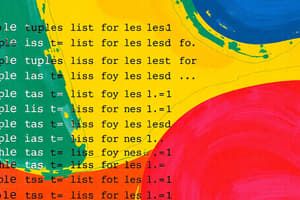Podcast
Questions and Answers
Which of the following is NOT a built-in sequence type in Python?
Which of the following is NOT a built-in sequence type in Python?
- Set (correct)
- String
- Tuple
- List
Lists in Python are immutable, meaning they cannot be changed after assignment.
Lists in Python are immutable, meaning they cannot be changed after assignment.
False (B)
What is the default starting index when slicing a list without specifying the first index?
What is the default starting index when slicing a list without specifying the first index?
0
In Python, the sequence type that allows duplication of items and maintains order is called a ______.
In Python, the sequence type that allows duplication of items and maintains order is called a ______.
Match the following control flow statements with their descriptions:
Match the following control flow statements with their descriptions:
What is the correct way to initialize a tuple with three items?
What is the correct way to initialize a tuple with three items?
Strings in Python are mutable data types.
Strings in Python are mutable data types.
What is the default starting value and step size of the range object?
What is the default starting value and step size of the range object?
A tuple is best used where order and _______ are meaningful.
A tuple is best used where order and _______ are meaningful.
Match the following sequence types with their properties:
Match the following sequence types with their properties:
What is the term used for types such as list, tuple, and string in programming?
What is the term used for types such as list, tuple, and string in programming?
The command used to exit a loop prematurely is called ____.
The command used to exit a loop prematurely is called ____.
Match the following programming concepts with their descriptions:
Match the following programming concepts with their descriptions:
What is the output of the code >>>
squares = [1,4,9,16,25]
squares[-3:]?
What is the output of the code >>>
squares = [1,4,9,16,25]
squares[-3:]?
Tuples in Python are mutable collections.
Tuples in Python are mutable collections.
Explain the result of li[1:3] when li = [5,4,2,0,9].
Explain the result of li[1:3] when li = [5,4,2,0,9].
The operation *= 2 applied to a slice of a list will _______ the elements in that slice.
The operation *= 2 applied to a slice of a list will _______ the elements in that slice.
Match the following list operations with their descriptions:
Match the following list operations with their descriptions:
What will the updated list be after executing li = [5,4,2,0,9]; li[1:3] *= 2?
What will the updated list be after executing li = [5,4,2,0,9]; li[1:3] *= 2?
You can sort a list using the sort() method without creating a new list.
You can sort a list using the sort() method without creating a new list.
What is meant by 'removing items from a list'?
What is meant by 'removing items from a list'?
The for loop can be used to iterate through every element in the list.
The for loop can be used to iterate through every element in the list.
Code:
items = ["hello", "-1", "xmas", "-1"]
for item in items:
if item == "-1":
continue
print(item)
What will happen when the item is equal to '-1' in the loop?
Code:
items = ["hello", "-1", "xmas", "-1"]
for item in items:
if item == "-1":
continue
print(item)
What will happen when the item is equal to '-1' in the loop?
Match the following terms with their descriptions:
Match the following terms with their descriptions:
Which of the following is not a valid evaluation method for determining a correct answer in the loop?
Which of the following is not a valid evaluation method for determining a correct answer in the loop?
An empty list can be defined without any initialization.
An empty list can be defined without any initialization.
Flashcards are hidden until you start studying
Study Notes
Built-in Types: Sequence Types
- Sequence types are used to store a collection of items in a specific order.
- Lists:
- Mutable, i.e., items can be added, removed, or changed after initialization.
- Can store items of different types (heterogeneous).
- Initialization:
list_name = [item_0, item_1, ..., item_n-1] - Empty list:
list_name = list()orlist_name = [] - Accessing items using indexing and slicing.
- Example:
squares = [1,4,9,16,25]squares[-3:]returns[9,16,25]li = [5,8,4,0,9]andli[1:3] *= 2results inli = [5,4,2,4,2,0,9]
- Tuples:
- Immutable, i.e., items are fixed after initialization.
- Typically used for collections of heterogeneous items, like (name, age, city).
- Initialization:
tuple_name = (item_0, item_1, ..., item_n-1) - Empty tuple:
tuple_name = ()ortuple_name = tuple() - Can be indexed and sliced just like lists.
- Range:
- Represents an immutable sequence of numbers.
- Used for looping a specific number of times in for loops.
- Initialization:
range_name = range(start, stop, step) - Default values:
start = 0,step = 1
- String (str):
- Immutable, used for storing textual data.
- Initialization:
string_name = 'text'orstring_name = str('text') - Can be indexed and sliced just like lists and tuples.
- Example:
- In a program that increases temperature iteratively by 1 degree until it reaches 25 degrees:
- The program uses a
forloop and awhileloop to achieve this.
- The program uses a
- In a program that increases temperature iteratively by 1 degree until it reaches 25 degrees:
Control Flow Statements
forLoop:- Iterates through each item in a sequence (e.g., list, tuple, range, string).
- Example:
for item in items: ...iterates through items in the listitems.
whileLoop:- Repeats a block of code as long as a condition is true.
- Example:
while temperature < 25: ...will continue looping until the temperature reaches 25 degrees.
if,else,elifStatements:- Used to execute different blocks of code depending on a condition.
breakStatement:- Terminates the current loop and jumps to the next iteration.
continueStatement:- Terminates the current iteration of the loop and jumps to the next iteration.
Comparison and Boolean Operations
- Comparison operators (==, !=, <, >, <=, >=) are used to compare values.
- Boolean operators (and, or, not) are used to combine or negate boolean expressions.
Studying That Suits You
Use AI to generate personalized quizzes and flashcards to suit your learning preferences.




